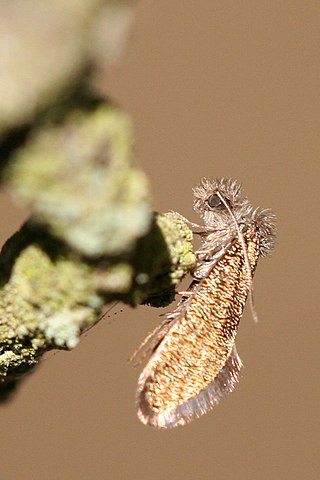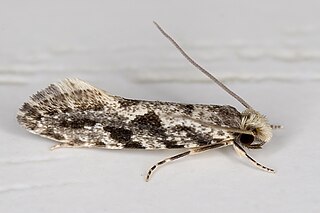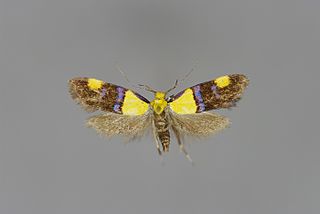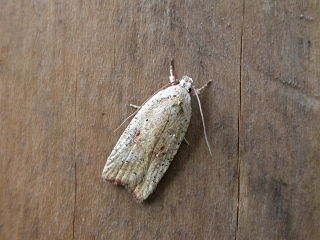
Dyseriocrania subpurpurella is a diurnal moth from the family Eriocraniidae, found in most of Europe. The moth was first named by the English entomologist, Adrian Hardy Haworth in 1828.

Orthonama obstipata, the gem, is a moth of the family Geometridae. The species was first described by Johan Christian Fabricius in 1794. It is a cosmopolitan species. In continental Europe though in the northeast, its range does not significantly extend beyond the Baltic region and it is absent from northern Russia. This well-flying species is prone to vagrancy and able to cross considerable distances of the open sea; it can thus be regularly found on the British Isles and even on Iceland.

Enarmonia formosana, the cherrybark tortrix or cherry-bark moth, is a small but colorful moth species of the family Tortricidae. It is native to all of northern and western Europe, ranging south to the Maghreb. North of the Alps its range extends eastwards to Siberia and Kazakhstan. Possibly and most likely introduced populations are found in Asia Minor and North America, respectively.

Argyresthia curvella is a species of ermine moth. It belongs to subfamily Argyresthiinae, which is sometimes elevated to full family rank in the superfamily Yponomeutoidea. It is commonly called apple blossom tineid, reflecting the fact that it was originally believed to be a tineid moth.

Euplocamus anthracinalis is a species of tineoid moth. It belongs to the fungus moth family (Tineidae), and among these to the subfamily Euplocaminae.

Monopis obviella is a species of tineoid moth. It belongs to the fungus moth family (Tineidae), and therein to the nominate subfamily Tineinae. It is the type species of Blabophanes, today treated as a junior synonym of the genus Monopis. M. crocicapitella was only separated from the present species in 1859, and is still frequently confused with it even by rather recent sources.

Nemapogon granella is a species of tineoid moth. It belongs to the fungus moth family (Tineidae), and therein to the subfamily Nemapogoninae. It is the type species of its genus Nemapogon, and via that also of the subfamily Nemapogoninae. It is also the type species of the proposed genera Brosis and Diaphthirusa, which are consequently junior objective synonyms of Nemapogon.

The brown-dotted clothes moth is a species of tineoid moth. It belongs to the fungus moth family (Tineidae), and therein to the nominate subfamily Tineinae. It is the type species of its genus Niditinea.

Nemapogon cloacella, the cork moth, is a species of tineoid moth. It belongs to the fungus moth family (Tineidae), and therein to the subfamily Nemapogoninae. Its junior synonym N. infimella was established by G.H. Heydenreich in the 1851 volume of his Lepidopterorum Europaeorum Catalogus Methodicus, but many sources still attribute it to G.A.W. Herrich-Schäffer, who supposedly narrowly beat Heidenreich in (re)describing the species. But as it seems, Herrich-Schäffer was merely one of the first to use the name proposed by Heydenreich, as the volume of his Systematische Bearbeitung der Schmetterlinge von Europa where he discussed the cork moth was not published until 1853 or 1854. That all nonwithstanding, the species had been already validly described by A.H. Haworth in the 1828 volume of Lepidoptera Britannica.

Oecophora bractella is a species of gelechioid moth. It belongs to the subfamily Oecophorinae of the concealer moth family (Oecophoridae). As the type species of its genus Oecophora, its affiliations and phylogeny determine the delimitation of that family and subfamily.

Batia lambdella is a species of gelechioid moth. It belongs to the subfamily Oecophorinae of the concealer moth family (Oecophoridae). The genus Batia is sometimes treated as monotypic, but this seems spurious considering how similar B. lambdella is to the type species B. lunaris.

Borkhausenia minutella is a species of moth. Within its superfamily, it is placed within the subfamily Oecophorinae of the "concealer moth" family, Oecophoridae.

Alabonia geoffrella is a species of gelechioid moth. Here, it is placed within the subfamily Oecophorinae of the concealer moth family (Oecophoridae). Alternatively it has been placed in the Elachistidae or Depressariinae together with its presumed closest relatives.

Agnoea flavifrontella is a species of gelechioid moths in the family Lypusidae.

The gorse tip moth is a smallish moth species of the family Depressariidae.

Monopis laevigella, the skin moth, is a species of tineoid moth. It belongs to the fungus moth family (Tineidae), and therein to the nominate subfamily Tineinae. It is the type species of the genus Monopis and its junior objective synonym Hyalospila. As with the common clothes moth, earlier authors frequently misapplied the name Tinea vestianella to the present species.

Tinea trinotella is a species of tineoid moth. It belongs to the fungus moth family (Tineidae), and therein to the nominate subfamily Tineinae. It was once used as type species of a distinct genus Acedes, but this is synonymized today with Tinea, the type genus of Tineinae, Tineidae and the superfamily Tineoidea.

Celypha aurofasciana is a small moth species of the family Tortricidae. It is native to Europe and the Palearctic but occurs in some other places as an introduced species.

The four-spotted yellowneck, also known as the leaf litter moth, is a species of gelechioid moth. It is native to Western Europe, from France to Belgium, Germany and Austria, south to the Iberian Peninsula, and north to Ireland, Wales and England. Older sources claim its range to extend further eastwards, but this seems to be based on misidentifications of related and very similar species. It is also found in southern Canada and throughout the United States.
Dichomeris mochlopis is a moth in the family Gelechiidae. It was described by Edward Meyrick in 1923. It is found in Amazonas, Brazil.




















